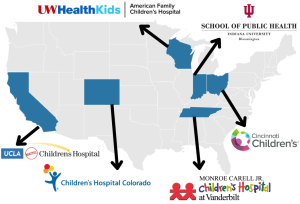The THRIvE study wants to understand how the group of people who help care for a child can impact a child’s health and well-being.
What does “THRIvE” stand for?
THRIvE — Teamwork and Healthy Relationships Improving Engagement in Caregiving
Where is this study taking place?
The THRIvE study is being led by the University of Wisconsin—Madison and Vanderbilt University Medical Center (VUMC) in collaboration with the following health care centers and universities across the United States:
- American Family Children’s Hospital (UW–Madison)
- Children’s Hospital Colorado (University of Colorado – Anschutz Medical Campus)
- Cincinnati Children’s Hospital (University of Cincinnati)
- Mattel Children’s Hospital (University of California, Los Angeles)
- Monroe Carell Jr. Children’s Hospital at Vanderbilt (Vanderbilt University Medical Center)
- Indiana University School of Public Health

Who is participating in the study?
We are inviting caregivers of children who receive ongoing care for chronic neurological conditions — such as cerebral palsy, epilepsy, hydrocephalus, genetic, and metabolic disorders — at one of the health care centers listed above.
Caregivers can include:
- Parents or guardians
- Adult siblings
- Grandparents or other relatives
- Neighbors and friends
- Home nurses
- Respite providers
- Teachers or daycare workers
- School aides
- Or anyone else who helps care for the child at home or in the community
We want to hear directly from the people who support these children day-to-day. We’re interested in learning who provides care, how often they help, and what kind of care they give.
How many people are participating?
We plan to enroll 400 caregiving networks. Each caregiving network will include a child, their parent or guardian, and anyone else the parent or guardian says helps care for the child on a regular basis. These caregivers can be many different kinds of people — like family members, teachers, school aides, home health workers, therapists, respite care providers, neighbors, social workers, daycare workers, or transportation aides.
Why are we doing this study?
We want to better understand how the group of people who help care for a child — what we call the caregiving network — can impact a child’s health and well-being. We are hoping to learn whether certain features of a child’s caregiving network — like how many caregivers they have, how they work together, who those caregivers are, and how often they help — are linked to better or worse health outcomes for the child.
We hope to answer questions like:
- How does the caregiving network affect a child’s health and quality of life?
- What types of caregivers are most common?
- How often do the caregivers interact with one another?
- Are children less likely to be hospitalized if certain types of caregivers are involved?
- What kinds of care or support are linked to better health?
Who is paying for this study?
The study is supported by the Eunice Kennedy Shriver National Institute of Child Health and Human Development of the National Institutes of Health under Award Number R01HD114789-01. The content is solely the responsibility of the authors and does not necessarily represent the official views of the NIH.
Do you have comments or questions?
Email us at thrive@pediatrics.wisc.edu.
